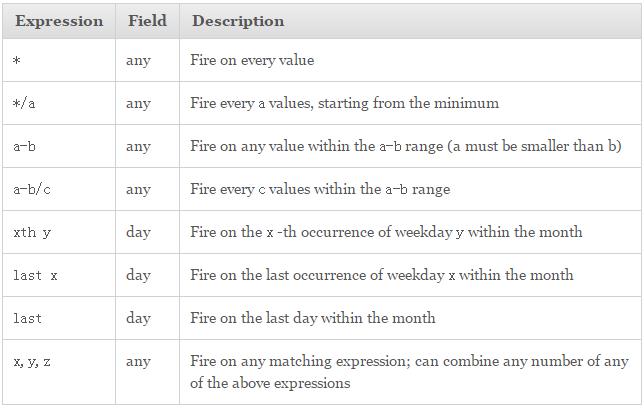Python APScheduler定时任务框架
Posted Harris-H
tags:
篇首语:本文由小常识网(cha138.com)小编为大家整理,主要介绍了Python APScheduler定时任务框架相关的知识,希望对你有一定的参考价值。
Python APScheduler定时任务框架
0.简介
APScheduler基于Quartz的一个Python定时任务框架,实现了Quartz的所有功能,使用起来十分方便。提供了基于日期、固定时间间隔以及crontab类型的任务,并且可以持久化任务。基于这些功能,我们可以很方便的实现一个python定时任务系统。
-
github:https://github.com/agronholm/apscheduler
-
官网文档:https://apscheduler.readthedocs.io/en/latest/
1.安装
pip install apscheduler
2.组成
APScheduler整个系统可以说由这五个概念组成:
- 触发器(trigger)包含调度逻辑,每一个作业有它自己的触发器,用于决定接下来哪一个作业会运行。除了他们自己初始配置意外,触发器完全是无状态的。
- 作业存储(job store)存储被调度的作业,默认的作业存储是简单地把作业保存在内存中,其他的作业存储是将作业保存在数据库中。一个作业的数据讲在保存在持久化作业存储时被序列化,并在加载时被反序列化。调度器不能分享同一个作业存储。
- 执行器(executor)处理作业的运行,他们通常通过在作业中提交制定的可调用对象到一个线程或者进城池来进行。当作业完成时,执行器将会通知调度器。
- 调度器(scheduler)是其他的组成部分。你通常在应用只有一个调度器,应用的开发者通常不会直接处理作业存储、调度器和触发器,相反,调度器提供了处理这些的合适的接口。配置作业存储和执行器可以在调度器中完成,例如添加、修改和移除作业。
- 任务(job):描述一个任务本身。
3.调度器IO模型
scheduler由于IO模型的不同,可以有多种实现:
- BlockingScheduler:main_loop就在当前进程的主线程内运行,所以调用start函数后会阻塞当前线程。通过一个threading.Event条件变量对象完成scheduler的定时唤醒。
- BackgroundScheduler:和BlockingScheduler基本一样,除了main_loop放在了单独线程里,所以调用start后主线程不会阻塞
- Asyncioscheduler:使用asyncio作为IO模型的scheduler,和AsyncIOExecutor配合使用,用asynio中event_loop的call_later完成定时唤醒
- GeventScheduler:和BlockingScheduler基本一样,使用gevent作为IO模型,和GeventExecutor配合使用
- QtScheduler:使用QTimer完成定时唤醒
- TornadoScheduler:使用tornado的IO模型,用ioloop.add_timeout完成定时唤醒
- TwistedScheduler:配合TwistedExecutor,用reactor.callLater完成定时唤醒
4.示例
a.BlockingScheduler
from apscheduler.schedulers.blocking import BlockingScheduler
def my_job():
print 'hello world'
scheduler = BlockingScheduler()
scheduler.add_job(my_job, 'interval', seconds=5)
scheduler.start()
上面的例子表示每隔5s执行一次my_job函数,输出hello world
b.BackgroundScheduler
from apscheduler.schedulers.background import BackgroundScheduler
def job3():
print(time.strftime('%Y-%m-%d %H:%M:%S',time.localtime(time.time())))
print("I'm working job_3")
scheduler = BackgroundScheduler()
scheduler.add_job(job3, 'interval', seconds=3) #间隔3秒钟执行一次
scheduler.start()
5.触发器(trigger)控制
a.interval 间隔调度
每隔多久执行
weeks (int) – number of weeks to wait
days (int) – number of days to wait
hours (int) – number of hours to wait
minutes (int) – number of minutes to wait
seconds (int) – number of seconds to wait
start_date (datetime|str) – starting point for the interval calculation
end_date (datetime|str) – latest possible date/time to trigger on
timezone (datetime.tzinfo|str) – time zone to use for the date/time calculations
#表示每隔3天17时19分07秒执行一次任务
sched.add_job(my_job, 'interval', days=03, hours=17, minutes=19, seconds=07)
#间隔3秒钟执行一次
scheduler.add_job(job3, 'interval', seconds=3)
b.date 定时调度
作业只会执行一次
run_date (datetime|str) – the date/time to run the job at -(任务开始的时间)
timezone (datetime.tzinfo|str) – time zone for run_date if it doesn’t have one already
#在指定的时间,只执行一次
scheduler.add_job(tick, 'date', run_date='2016-02-14 15:01:05')
# The job will be executed on November 6th, 2009
sched.add_job(my_job, 'date', run_date=date(2009, 11, 6), args=['text'])
# The job will be executed on November 6th, 2009 at 16:30:05
sched.add_job(my_job, 'date', run_date=datetime(2009, 11, 6, 16, 30, 5), args=['text'])
c.cron定时调度
(int|str) 表示参数既可以是int类型,也可以是str类型
(datetime | str) 表示参数既可以是datetime类型,也可以是str类型
year (int|str) – 4-digit year -(表示四位数的年份,如2008年)
month (int|str) – month (1-12) -(表示取值范围为1-12月)
day (int|str) – day of the (1-31) -(表示取值范围为1-31日)
week (int|str) – ISO week (1-53) -(格里历2006年12月31日可以写成2006年-W52-7(扩展形式)或2006W527(紧凑形式))
day_of_week (int|str) – number or name of weekday (0-6 or mon,tue,wed,thu,fri,sat,sun) - (表示一周中的第几天,既可以用0-6表示也可以用其英语缩写表示)
hour (int|str) – hour (0-23) - (表示取值范围为0-23时)
minute (int|str) – minute (0-59) - (表示取值范围为0-59分)
second (int|str) – second (0-59) - (表示取值范围为0-59秒)
start_date (datetime|str) – earliest possible date/time to trigger on (inclusive) - (表示开始时间)
end_date (datetime|str) – latest possible date/time to trigger on (inclusive) - (表示结束时间)
timezone (datetime.tzinfo|str) – time zone to use for the date/time calculations (defaults to scheduler timezone) -(表示时区取值)
参数的取值格式:

#表示2017年3月22日17时19分07秒执行该程序
sched.add_job(my_job, 'cron', year=2017,month = 03,day = 22,hour = 17,minute = 19,second = 07)
#表示任务在6,7,8,11,12月份的第三个星期五的00:00,01:00,02:00,03:00 执行该程序
sched.add_job(my_job, 'cron', month='6-8,11-12', day='3rd fri', hour='0-3')
#表示从星期一到星期五5:30(AM)直到2014-05-30 00:00:00
sched.add_job(my_job(), 'cron', day_of_week='mon-fri', hour=5, minute=30,end_date='2014-05-30')
#表示每5秒执行该程序一次,相当于interval 间隔调度中seconds = 5
sched.add_job(my_job, 'cron',second = '*/5')
6.参考文章
https://www.cnblogs.com/shhnwangjian/p/7877985.html
以上是关于Python APScheduler定时任务框架的主要内容,如果未能解决你的问题,请参考以下文章